I-doit adalah alat manajemen aset sumber terbuka yang dapat digunakan untuk mengelola seluruh sistem TI. Hal ini didasarkan pada manajemen konfigurasi sumber terbuka lengkap dan database yang memungkinkan Anda untuk melacak aset perangkat lunak dan perangkat keras dan hubungan mereka. Dengan i-doit, Anda dapat mendokumentasikan seluruh sistem TI dan perubahannya, menampilkan informasi penting dan memastikan operasi jaringan TI yang stabil dan efisien.
Ini menawarkan berbagai fitur termasuk, Manajemen Aset, Perencanaan Infrastruktur, Sistem Tiket, Manajemen Kabel, Inventaris, SAN, Manajemen Alamat IP, Cluster, Manajemen Patch, dan banyak lagi.
Dalam tutorial ini, kami akan menjelaskan cara menginstal I-doit Asset Management System di Ubuntu 20.04.
Prasyarat
- Server yang menjalankan Ubuntu 20.04 dengan RAM minimal 2GB.
- Nama domain valid yang ditunjukkan dengan IP server Anda.
- Kata sandi root dikonfigurasi di server.
Instal Server LAMP
Pertama, Anda perlu menginstal server web Apache, server database MariaDB, PHP, dan ekstensi PHP lain yang diperlukan di sistem Anda. Anda dapat menginstal semuanya dengan perintah berikut:
apt-get install apache2 mariadb-server libapache2-mod-php7.4 php7.4-bcmath php7.4-cli php7.4-common php7.4-curl php7.4-gd php7.4-json php7.4-ldap php7.4-mbstring php7.4-mysql php7.4-opcache php7.4-pgsql php7.4-soap php7.4-xml php7.4-zip php7.4-imagick php7.4-memcached unzip wget curl memcached moreutils -y
Setelah semua paket diinstal, buat file php.ini baru untuk I-doit dengan nilai yang diinginkan:
nano /etc/php/7.4/mods-available/i-doit.ini
Tambahkan baris berikut:
allow_url_fopen = Yes file_uploads = On magic_quotes_gpc = Off max_execution_time = 300 max_file_uploads = 42 max_input_time = 60 max_input_vars = 10000 memory_limit = 256M post_max_size = 128M register_argc_argv = On register_globals = Off short_open_tag = On upload_max_filesize = 128M display_errors = Off display_startup_errors = Off error_reporting = E_ALL & ~E_DEPRECATED & ~E_STRICT log_errors = On default_charset = "UTF-8" default_socket_timeout = 60 date.timezone = Asia/Kolkata session.gc_maxlifetime = 604800 session.cookie_lifetime = 0 mysqli.default_socket = /var/run/mysqld/mysqld.sock
Simpan dan tutup file setelah Anda selesai. Kemudian, terapkan konfigurasi dan aktifkan modul memcached dengan perintah berikut:
phpenmod i-doit
phpenmod memcached
Selanjutnya, restart layanan Apache untuk menerapkan perubahan:
systemctl restart apache2
Konfigurasikan MariaDB untuk Performa Lebih Baik
Selanjutnya, Anda perlu mengkonfigurasi server MariaDB untuk kinerja yang lebih baik. Anda dapat melakukannya dengan membuat file konfigurasi baru:
nano /etc/mysql/mariadb.conf.d/99-i-doit.cnf
Tambahkan baris berikut:
[mysqld] innodb_buffer_pool_size = 1G innodb_buffer_pool_instances = 1 innodb_log_file_size = 512M innodb_sort_buffer_size = 64M sort_buffer_size = 262144 # default join_buffer_size = 262144 # default max_allowed_packet = 128M max_heap_table_size = 32M query_cache_min_res_unit = 4096 query_cache_type = 1 query_cache_limit = 5M query_cache_size = 80M tmp_table_size = 32M max_connections = 200 innodb_file_per_table = 1 innodb_thread_concurrency = 0 innodb_flush_log_at_trx_commit = 1 innodb_flush_method = O_DIRECT innodb_lru_scan_depth = 2048 table_definition_cache = 1024 table_open_cache = 2048 innodb_stats_on_metadata = 0 sql-mode = ""
Simpan dan tutup file setelah Anda selesai. Kemudian, masuk ke shell MariaDB dengan perintah berikut:
mysql
Setelah login, ubah plugin otentikasi MariaDB menjadi mysql_native_password dengan perintah berikut:
MariaDB [(none)]> SET GLOBAL innodb_fast_shutdown = 0;
MariaDB [(none)]> UPDATE mysql.user SET plugin = 'mysql_native_password' WHERE User = 'root';
Selanjutnya, flush hak istimewa dan keluar dari shell MariaDB dengan perintah berikut:
MariaDB [(none)]> FLUSH PRIVILEGES;
MariaDB [(none)]> EXIT;
Terakhir, restart layanan MariaDB untuk menerapkan perubahan:
systemctl restart mariadb
Unduh I-doit
Pertama, Anda perlu mengunduh versi terbaru I-doit dari situs web Sourceforge. Anda dapat menggunakan perintah wget untuk mengunduhnya:
wget https://excellmedia.dl.sourceforge.net/project/i-doit/i-doit/1.14/idoit-open-1.14.zip
Setelah diunduh, unzip file yang diunduh ke direktori root web Apache dengan perintah berikut:
unzip idoit-open-1.14.2.zip -d /var/www/html/idoit
Selanjutnya, ubah kepemilikan menjadi pengguna www-data dan atur izin yang sesuai dengan perintah berikut:
chown -R www-data:www-data /var/www/html/idoit/
chmod -R 775 /var/www/html/idoit/
Setelah selesai, Anda dapat melanjutkan ke langkah berikutnya.
Konfigurasi Server Web Apache
Selanjutnya, buat file konfigurasi virtual host Apache untuk I-doit.
nano /etc/apache2/sites-available/idoit.conf
Tambahkan baris berikut:
<VirtualHost *:80>
ServerAdmin [email protected]
ServerName idoit.linuxbuz.com
DirectoryIndex index.php
DocumentRoot /var/www/html/idoit
<Directory /var/www/html/idoit>
AllowOverride All
Require all granted
</Directory>
LogLevel warn
ErrorLog ${APACHE_LOG_DIR}/error.log
CustomLog ${APACHE_LOG_DIR}/access.log combined
</VirtualHost>
Simpan dan tutup file setelah Anda selesai. Kemudian, aktifkan virtual host dan modul penulisan ulang Apache dengan perintah berikut:
a2ensite idoit
a2enmod rewrite
Selanjutnya, restart layanan Apache untuk menerapkan perubahan:
systemctl restart apache2
Amankan I-doit dengan Let's Encrypt SSL
Untuk mengamankan situs web I-doit Anda dengan Let's Encrypt SSL, Anda perlu menginstal paket klien Certbot di server Anda. Anda dapat menginstalnya dengan perintah berikut:
apt-get install python3-certbot-apache -y
Setelah terinstal, jalankan perintah berikut untuk mengamankan situs web Anda dengan Let's Encrypt SSL:
certbot --apache -d idoit.linuxbuz.com
Anda harus memberikan alamat email yang valid dan menerima persyaratan layanan seperti yang ditunjukkan di bawah ini:
Saving debug log to /var/log/letsencrypt/letsencrypt.log Plugins selected: Authenticator apache, Installer apache Enter email address (used for urgent renewal and security notices) (Enter 'c' to cancel): [email protected] - - - - - - - - - - - - - - - - - - - - - - - - - - - - - - - - - - - - - - - - Please read the Terms of Service at https://letsencrypt.org/documents/LE-SA-v1.2-November-15-2017.pdf. You must agree in order to register with the ACME server at https://acme-v02.api.letsencrypt.org/directory - - - - - - - - - - - - - - - - - - - - - - - - - - - - - - - - - - - - - - - - (A)gree/(C)ancel: A - - - - - - - - - - - - - - - - - - - - - - - - - - - - - - - - - - - - - - - - Would you be willing to share your email address with the Electronic Frontier Foundation, a founding partner of the Let's Encrypt project and the non-profit organization that develops Certbot? We'd like to send you email about our work encrypting the web, EFF news, campaigns, and ways to support digital freedom. - - - - - - - - - - - - - - - - - - - - - - - - - - - - - - - - - - - - - - - - (Y)es/(N)o: Y Obtaining a new certificate Performing the following challenges: http-01 challenge for idoit.linuxbuz.com Enabled Apache rewrite module Waiting for verification... Cleaning up challenges Created an SSL vhost at /etc/apache2/sites-available/idoit-le-ssl.conf Enabled Apache socache_shmcb module Enabled Apache ssl module Deploying Certificate to VirtualHost /etc/apache2/sites-available/idoit-le-ssl.conf Enabling available site: /etc/apache2/sites-available/idoit-le-ssl.conf
Selanjutnya, pilih apakah akan mengarahkan lalu lintas HTTP ke HTTPS seperti yang ditunjukkan di bawah ini:
Please choose whether or not to redirect HTTP traffic to HTTPS, removing HTTP access. - - - - - - - - - - - - - - - - - - - - - - - - - - - - - - - - - - - - - - - - 1: No redirect - Make no further changes to the webserver configuration. 2: Redirect - Make all requests redirect to secure HTTPS access. Choose this for new sites, or if you're confident your site works on HTTPS. You can undo this change by editing your web server's configuration. - - - - - - - - - - - - - - - - - - - - - - - - - - - - - - - - - - - - - - - - Select the appropriate number [1-2] then [enter] (press 'c' to cancel): 2
Ketik 2 dan tekan Enter untuk menginstal Let's Encrypt SSL untuk situs web Anda:
Enabled Apache rewrite module Redirecting vhost in /etc/apache2/sites-enabled/idoit.conf to ssl vhost in /etc/apache2/sites-available/idoit-le-ssl.conf - - - - - - - - - - - - - - - - - - - - - - - - - - - - - - - - - - - - - - - - Congratulations! You have successfully enabled https://idoit.linuxbuz.com You should test your configuration at: https://www.ssllabs.com/ssltest/analyze.html?d=idoit.linuxbuz.com - - - - - - - - - - - - - - - - - - - - - - - - - - - - - - - - - - - - - - - - IMPORTANT NOTES: - Congratulations! Your certificate and chain have been saved at: /etc/letsencrypt/live/idoit.linuxbuz.com/fullchain.pem Your key file has been saved at: /etc/letsencrypt/live/idoit.linuxbuz.com/privkey.pem Your cert will expire on 2020-10-17. To obtain a new or tweaked version of this certificate in the future, simply run certbot again with the "certonly" option. To non-interactively renew *all* of your certificates, run "certbot renew" - Your account credentials have been saved in your Certbot configuration directory at /etc/letsencrypt. You should make a secure backup of this folder now. This configuration directory will also contain certificates and private keys obtained by Certbot so making regular backups of this folder is ideal. - If you like Certbot, please consider supporting our work by: Donating to ISRG / Let's Encrypt: https://letsencrypt.org/donate Donating to EFF: https://eff.org/donate-le
Setelah selesai, Anda dapat melanjutkan ke langkah berikutnya.
Mengakses Antarmuka Web I-doit
Sekarang, buka browser web Anda dan akses I-doit menggunakan URL https://idoit.linuxbuz.com. Anda akan melihat layar pemeriksaan sistem:

Pastikan semua paket yang diperlukan sudah terinstal. Kemudian, klik tombol Berikutnya tombol. Anda akan melihat layar konfigurasi direktori:
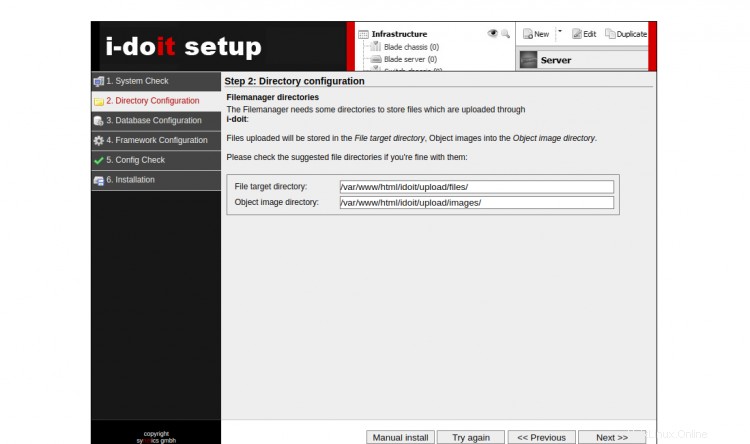
Berikan jalur direktori pengelola file yang Anda inginkan dan klik Berikutnya tombol. Anda akan melihat layar konfigurasi database:
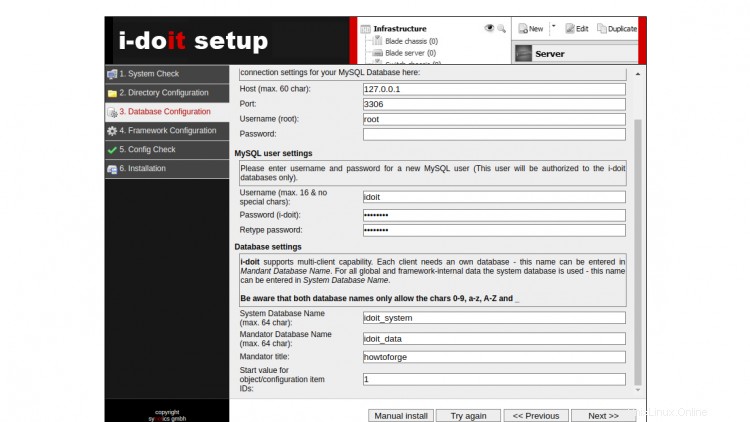
Berikan informasi basis data yang Anda inginkan dan klik Berikutnya tombol. Anda akan melihat layar konfigurasi pengguna admin:
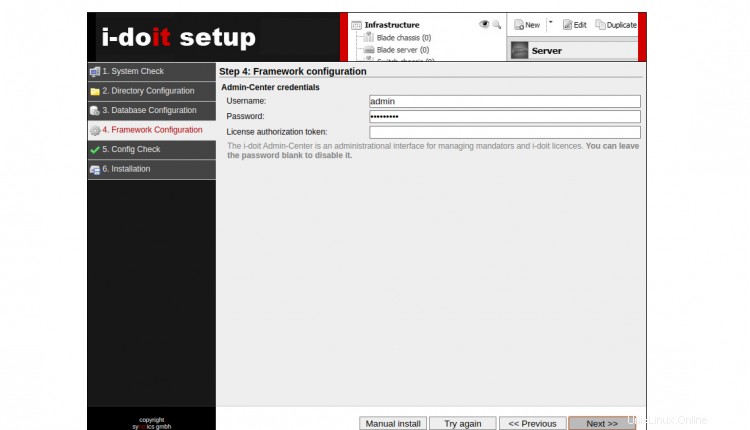
Berikan nama pengguna, kata sandi admin Anda, dan klik tombol Berikutnya tombol. Anda akan melihat layar pratinjau konfigurasi:
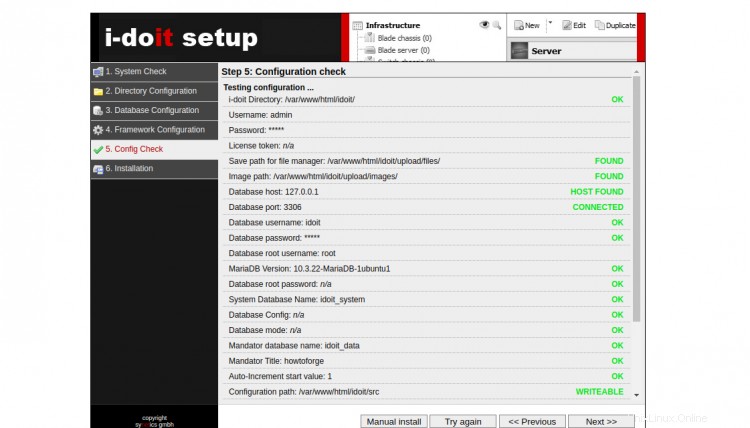
Klik Berikutnya tombol untuk memulai instalasi. Setelah penginstalan selesai, Anda akan melihat layar berikut:
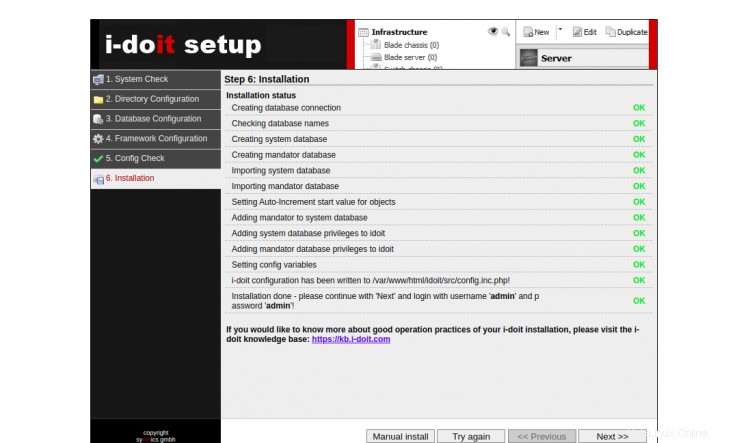
Klik Berikutnya tombol. Anda akan melihat layar login I-doit:
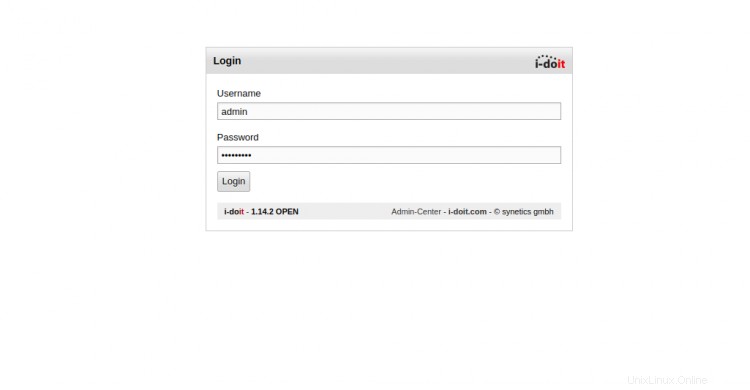
Berikan nama pengguna, kata sandi admin Anda, dan klik Masuk tombol. Anda akan melihat dasbor I-doit di layar berikut:

Kesimpulan
Selamat! Anda telah berhasil menginstal Sistem Manajemen Aset I-doit di Ubuntu 20.04 dengan Let's Encrypt SSL. Anda sekarang dapat mengelola aset perangkat keras dan perangkat lunak Anda melalui browser web. Jangan ragu untuk bertanya kepada saya jika Anda memiliki pertanyaan.